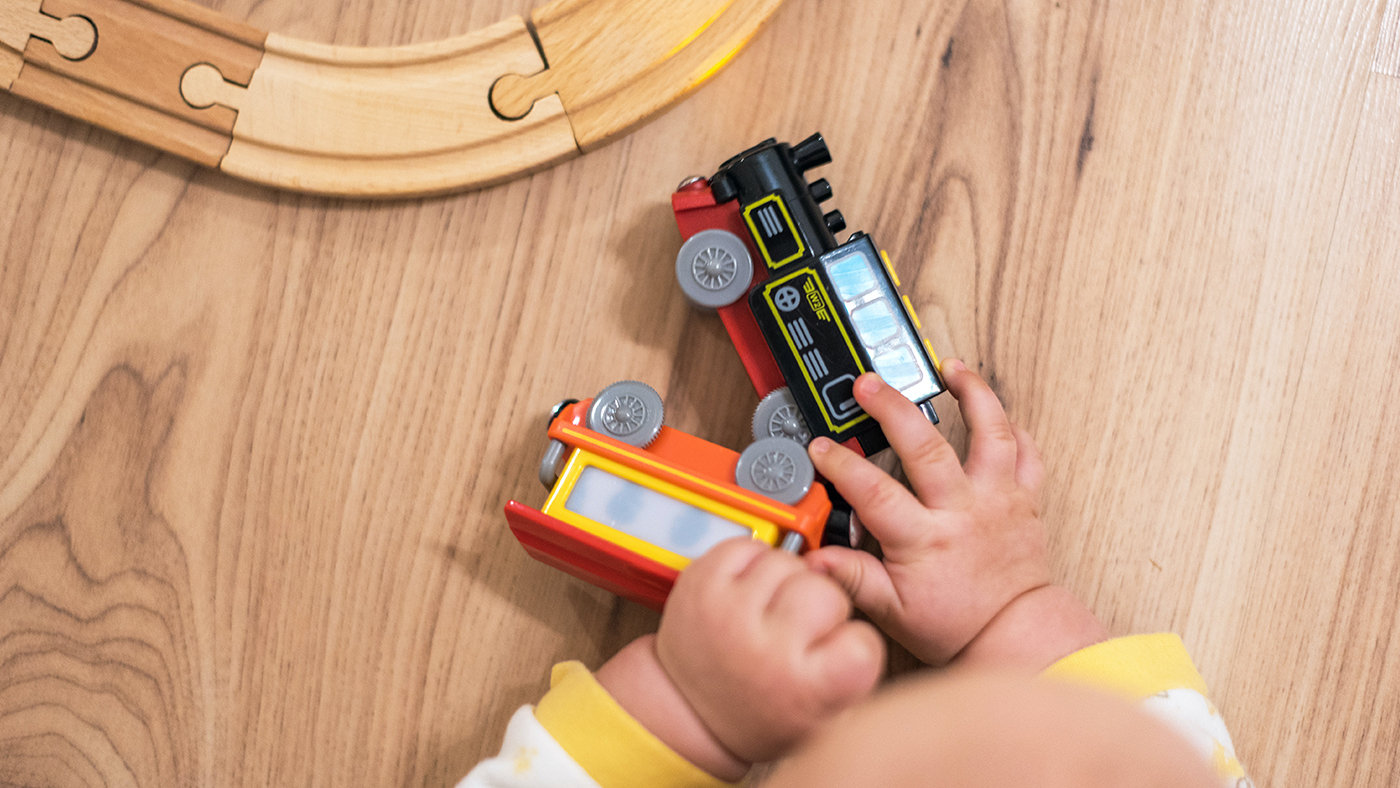Picks up objects in palm using thumb and first two fingers with other fingers flexed for support

Your baby has been developing their ability to use their hands and arms to intentionally grip objects. They will have begun to reach for items which interest them, often holding them in the centre of their palm.
Now they will hold items more securely in their hand with their thumb and first two fingers curved around the object, and their other fingers curled inwards for support. This gives your baby more control over the item and it is known as a radial palmer grasp [1].
Holding on
Radial refers to the side of the hand closest to the thumb. You might have noticed your baby started gripping items by holding them closer to their little finger but as they’ve built up their skills over time, they begin to hold objects on the side closer to their thumb because this gives them more control.
This is an important step in developing grasp because it shows your baby is learning to use each finger independently to improve their grip. Over time (and with lots of practice) this will lead to them being able to use their thumb and fingers to explore items in more detail and to pick up very tiny objects [2].
Over time using fingers independently of each other will also help your baby to communicate through gestures and pointing. You might be beginning to notice them responding to your gestures by looking in a certain direction when you point to new or interesting things.
The skills being used when your baby grasps an object will be helpful throughout their life. You might notice them coming into their own when your baby begins to test their independence, as it will allow them to feed themselves by controlling finger foods or (as they get older) using cutlery. It is a long way off, but it will also support their ability to do all the fiddly fastenings on their clothes and even build up to writing skills one day.
Reaching and grasping
Gripping and holding on are skills your baby will be keen to practise (often on your keys or phone) so encourage them by offering interesting objects as part of your daily play. It is important to ensure any items you offer are safe for your baby to explore as they will be very likely to want to have a taste while they are discovering them.
Try offering a selection of simple items such as small blocks, teethers, or even a soft hairbrush! Developing strong fingers and thumbs will be valuable for future fine motor skills, another way to encourage this is to use signs or gestures when singing nursery rhymes. Over time encourage your baby to copy the actions using their fingers and hands.
What next?
Your baby will develop their skills to begin to grasp items more confidently and hold on to more complex shapes. Over time they will be able to control their grasp to hold items for a reason, like being able to hold and drink from a cup. Your baby will need lots of opportunities to move, stretch and grab in order to strengthen the muscles in their arms and hands. Eventually they will begin to use their fingertips, rather than their whole hand, to pick things up.
Developing control over individual fingers will also allow your baby to decide when to drop objects [3]. They will experiment with opening their hand at times of their choosing to pass, place or drop things in their own time. Over the next few months your baby may decide that testing this new skill by dropping as many items as possible is just what they need to be doing.
References
[1] Amrhein, S (2016). Fine Motor Milestones and Facilitation [online]. Available at: https://www.childsplaytherapycenter.com/fine-motor-milestones-facilitation/
[2] Feldman, H.M. and Chaves-Gnecco, D. (2018) ‘Developmental/Behavioral Pediatrics’ in Zitelli, B. McIntire, S. and Nowalk, A (eds) Zitelli and Davis' Atlas of Pediatric Physical Diagnosis. Philadelphia: Elsevier.
[3] Lipkin, P. (2009) ‘Motor Development and Dysfunction’ in Carey, W. Crocker, A. Coleman, W. Elias, E. and Feldman, H.M. (eds) Developmental-Behavioral Pediatrics (4th Edition). Philadelphia: Saunders.